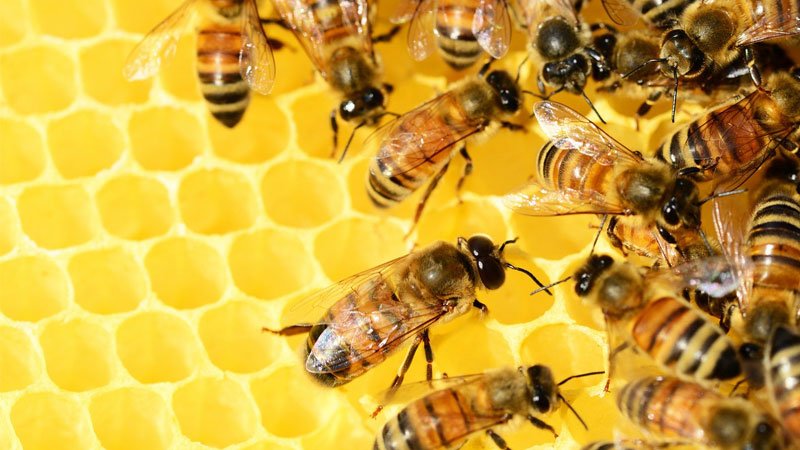A month ago I went on a wonderful Permaculture course with Patrick Whitefield on Ragmans Lane Farm in the Wye Valley. The course was one of the best things that I have ever done (in addition to my different courses in complementary medicine of course). It was a real combination of practical, and expansive, mind blowing information on living sustainably, growing food and working with nature. Not only does this way of living help you increase food production on your garden/land, but you also increase long term soil fertility and bio-diversity at the same time, and much more besides. It was absolutely fabulous!
Protecting honey bees
Whilst we were on the course, a rather spectacular evening on “Wild Bees” was presented to us by Brigit Strawbrige (from the TV programme “It”s Not Easy Being Green”). Brigit’s presentation was a real inspiration. I knew more people were beginning to look into protecting honey bees from the massive impact that pesticide use and habitat destruction has wrought, but the picture is a great deal more diverse than I had realised.
Brigit has dedicated herself to protecting wild bee populations. There are around 250 species of wild bees, divided into around 25 types of Bumble bees and Cuckoo bees, the rest being various forms of Solitary bees. It would seem that our highly diverse indigenous wild bees have been somewhat over-looked in regard to considering the impact of insect deaths in relation to pesticide use. However, I now agree whole-heartedly that it is vital we begin to take more notice and care of all our pollinators, not just the more visible ones that have a more obvious commercial value attached to them.
Our survival as a human race is directly connected to and reliant on the pollinating insects that are currently disappearing – almost unnoticed – from our gardens and hedgerows, and it can be alarmingly easy to miss their eradication. The smallest Solitary bee is the size of a grain of rice!
Brigit explained that one of the most devastating and recent pesticides to reap the most profoundly destructive impact on our precious bees and other insects is a range of endemic pesticides produced by Bayer Crop Science – called Neonicotinoids. One of the worst culprits – Imidocloprid – is a nerve toxin to all insects – especially bees – and is 7000 times more toxic to bees than DDT.
In 2010 over one third of our arable land in the UK (that’s about 9.9 million acres) was contaminated with this form of pesticide. Other European countries have now restricted the use of these profoundly dangerous chemicals as a result of bee deaths. So, why are we dragging our heels over this?
If you are interested and want to know more about what you can do to help – please read Brigit’s fascinating blog which is full of wonderful and uplifting facts about bees – as well as tips on what we can all do in our gardens to help our wild bees. You can also visit www.beeguardianfoundation.org.
Interesting facts about bees
I learnt so many wonderful things about Bumble bees – which have long been a special favourite of mine. Did you know that when they alight on a flower they leave a little scent footprint, which tells other bees that they’ve had the nectar recently – so not to bother looking! This wears off by the time the flower’s nectar reserves have refilled!
Some Solitary bees make a little nest in a hole (or hollow tube – see those bee hotels). The female bee provisions the nest with pollen and nectar into which she lays a single egg. She blocks the cell off with mud or leaves and then repeats the process again and again till she reaches the end of the tube. Once the eggs hatch out, the larvae feed on the pollen and nectar before becoming pupas. They leave the nest as fully adult bees the next year and buzz off to find flowers (and a lady bee, no doubt).
This is placed right next to the egg so when the baby bee hatches out it has nectar to drink. When the egg is laid and the cup is in place the mother bee then seals it into a little safe cell with mud she gathers. Once the baby hatches and is fortified with the nectar drink, it burrows out, and buzzes off to find flowers (and a lady bee, no doubt).
I also now know that certain Bumbles can be sexed by looking for a little yellow moustache, and this is just a drop in the ocean – there’s so much more to learn.
I now mow pathways along my lawn, rather than mow the whole thing, to leave the Clover, Buttercups, Daisies and Self Heal to grow and feed the wild bees – particularly during July and August. Just doing this in the last month has increased the number of Bumbles we’ve had in our garden dramatically, even though it’s been such a wet Summer. There’s also special flowers you can plant (or allow to grow) that are real favourites for our little fuzzy friends – please read up more on this fascinating subject!
Benefits of honey for health and skincare
Meanwhile – I want to tell you a little bit about honey, and why it’s so important in health and skincare. It’s a slow release sugar (lower on the glyceamic index than refined sugar) full of amino-acids, trace vitamins, minerals and other nutrients (including niacin, riboflavin, pantothenic acid, calcium, copper, iron, magnesium, manganese, phosphorous, potassium and zinc). I won’t bother to wax lyrical about the taste – but it’s a treat you can enjoy whilst doing yourself good!
When used in skincare honey has an ability to help our skin absorb and retain moisture, so it helps rehydration and prevents the skin drying out. It is a natural antioxidant and has powerful anti-microbial properties. It helps to rejuvenate and refresh the skin, making it feel soft, smooth and supple.
Try these recipes and see/feel the results for yourself…
Rich Face Pack for Normal Skin:
2 tbsp honey
2 tbsp mashed avocado
1 egg yolk
2 drops Geranium and 2 drops of Lavender essential oil
Mix well and apply – leave on for 20 minutes. Wash off and splash face with cold water to finish.
Face Pack For Dry Skin:
1 tbsp honey
1 egg yolk
1 tbsp plain yogurt
1 tsp Sweet Almond Oil
1 tsp oatmeal
1 drop German Chamomile essential oil
Mix and apply as above.
If you have dry skin, you can also try adding 2 tbsp of honey to your bath!
Honey Hair Shiner:
After shampooing your hair, try adding 1 tbsp honey to a pint of warm water. Mix well and pour onto hair, massaging it well into the scalp. Leave on for 1 hour and then rinse. You could also try adding honey to our Hair Conditioner base.
Skin Toner:
Try adding 1 tbsp of honey to 150ml Orange Flower Hydrolat. Shake well. Use as a skin toner every morning and evening, to help prevent spots and dry skin.
Joannah Metcalfe
Consultant Aromatherapist
Disclaimer & Safety Advice

